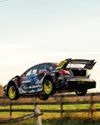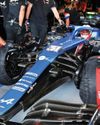
In RE V30N5 we considered the various types of differentials, in their ‘open’ form. We noted a differential is a gear mechanism that splits the power from one input shaft between two output shafts, providing a fixed torque split while allowing free variation of the output shaft speeds with respect to each other.
This property can create a problem when the distribution of available traction at individual wheels is different to the distribution of torque provided by the differential. In such situations, one or more wheels will spin prematurely and the traction of others will not be fully utilised.
Methods of modifying the differential’s characteristics to reduce this tendency generally involve introducing some form of friction, usually within the differential itself, though sometimes through the use of a brake. It is also possible in some applications to drive two output shafts from a single input shaft with devices that are not properly differentials.
Friction within the differential can be provided by clutches, by gear design, by some form of viscous coupling or by a combination of these. The friction can be constant, torque dependent, speed-dependent or controlled electronically, either by a computer or by a manually-operated control.
Clutch packs
The most popular approach is to use either one or two multi-disc clutch packs within the differential unit. These introduce friction between the carrier and one or both output shafts. It is sufficient to have this on only one output shaft, because the mean rotational velocity of the two shafts has to equal the input velocity, and therefore restricting the speed difference between one output shaft and the carrier also restricts the speed difference between the other output shaft and the carrier, and restricts the speed difference between the two output shafts.
This story is from the July 2020 edition of Racecar Engineering.
Start your 7-day Magzter GOLD free trial to access thousands of curated premium stories, and 8,500+ magazines and newspapers.
Already a subscriber ? Sign In
This story is from the July 2020 edition of Racecar Engineering.
Start your 7-day Magzter GOLD free trial to access thousands of curated premium stories, and 8,500+ magazines and newspapers.
Already a subscriber? Sign In
Talk the torque
More thoughts on in-wheel motors and their effects on twisting force
Rolling about
An explanation of the limitations of a previous load transfer article, bringing jacking forces into the mix
F1 breaks schedule records
The FIA has confirmed no fewer than 23 races on the 2022 Formula 1 World Championship schedule, the highest number of grands prix ever to be held in a single season, and that has led to criticism from some teams that will be on the road for eight months.

Under pressure
Toyota may have finished first and second at Le Mans this year, but the effort required to overcome a fuel delivery problem and finish with both cars was Herculean
Physics at work
Dutch company, Intrax, offers Racecar Engineering an insight into the technologies it employs to optimise its suspension products
Williams' 2030 ambition
Williams Racing has committed to becoming climate positive by 2030 as part of an all-new sustainability strategy.
Diff'rent strokes
Racecar looks at the different types of mechanical differential, their benefits and limitations
Das Boot
A curious Twitter exchange fired up a unique, hydrogen-powered, cross-country project that will contest the Baja 1000 in November 2022

Air born
Every racecar engineer's dream is a blank sheet of paper design. When Hoonigan and Subaru approached Vermont Sportscars about building the next generation of Gymkhana racer, that's just what the company was given

Remote control
Called variously ‘virtual garages’, ‘mission control’ or ‘race support rooms’ is the future of race engineering sitting in the warm back at HQ?